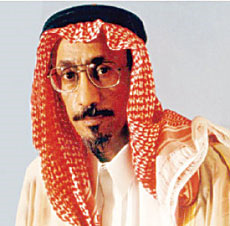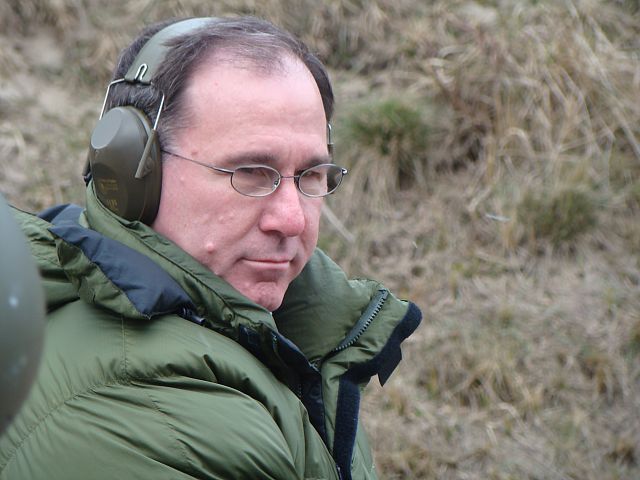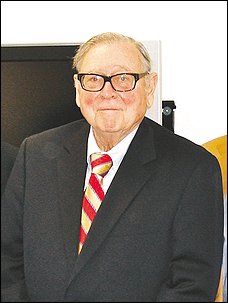Alex Constantine - October 15, 2010
Khalid bin Mahfouz was a participant or observer in the following events ...
Bush during his Harken days. [Source: Lions Gate Films]Prior to this year, President George W. Bush is a failed oilman. Three times, friends and investors have bailed him out to keep his business from going bankrupt. However, in 1988, the same year his father becomes president, some Saudis buy a portion of his small company, Harken, which has never performed work outside of Texas. Later in the year, Harken wins a contract in the Persian Gulf and starts doing well financially. These transactions seem so suspicious that the Wall Street Journal in 1991 states it “raises the question of… an effort to cozy up to a presidential son.” Two major investors in Bush’s company during this time are Salem bin Laden and Khalid bin Mahfouz. Salem bin Laden dies in a plane crash in Texas in 1988. [Intelligence Newsletter, 3/2/2000; Salon, 11/19/2001] Salem bin Laden is Osama’s oldest brother; Khalid bin Mahfouz is a Saudi banker with a 20 percent stake in BCCI. The bank will be shut down a few years later and bin Mahfouz will have to pay a $225 million fine (while admitting no wrongdoing) (see October 10, 2001)). [Forbes, 3/18/2002]
![]() The “Bin Laden brothers.” Their first names are not mentioned. They give money to Osama bin Laden. UPI will later point out that “the discovery of this document in Sarajevo calls into question whether al-Qaeda has received support from one of Osama’s scores of wealthy brothers.”
The “Bin Laden brothers.” Their first names are not mentioned. They give money to Osama bin Laden. UPI will later point out that “the discovery of this document in Sarajevo calls into question whether al-Qaeda has received support from one of Osama’s scores of wealthy brothers.”
![]() Adel Batterjee, a wealthy Saudi businessman who is also the founder of both BIF and its predecessor, Lajnatt Al-Birr Al-Islamiah. He appears to be mentioned as a recipient three times. [United Press International, 2/11/2003] The US will declare him as a terrorist financier in 2004 (see December 21, 2004).
Adel Batterjee, a wealthy Saudi businessman who is also the founder of both BIF and its predecessor, Lajnatt Al-Birr Al-Islamiah. He appears to be mentioned as a recipient three times. [United Press International, 2/11/2003] The US will declare him as a terrorist financier in 2004 (see December 21, 2004).
![]() Wael Hamza Julaidan, a Saudi millionaire and one of the founders of al-Qaeda. He is listed as a recipient. The US will declare him a terrorist financier in 2002 (see September 6, 2002).
Wael Hamza Julaidan, a Saudi millionaire and one of the founders of al-Qaeda. He is listed as a recipient. The US will declare him a terrorist financier in 2002 (see September 6, 2002).
![]() Saleh Kamel, a Saudi billionaire, and the majority shareholder of the Saudi conglomerate Dallah Albaraka. In 2003, Forbes will call him one of the richest people in the world. The list has him giving money to Batterjee.
Saleh Kamel, a Saudi billionaire, and the majority shareholder of the Saudi conglomerate Dallah Albaraka. In 2003, Forbes will call him one of the richest people in the world. The list has him giving money to Batterjee.
![]() Sulaiman Abdul Aziz al-Rajhi, another Saudi billionaire. The SAAR network, which is named after him, will be raided by the FBI in 2002 (see March 20, 2002). [Emerson, 2006, pp. 400]
Sulaiman Abdul Aziz al-Rajhi, another Saudi billionaire. The SAAR network, which is named after him, will be raided by the FBI in 2002 (see March 20, 2002). [Emerson, 2006, pp. 400]
![]() Khalid bin Mahfouz, another Saudi billionaire. A lawyer for bin Mahfouz will later say bin Mahfouz did contribute a small amount to fund the mujaheddin in the late 1980s, but only at the behest of the US and Saudi Arabia. [Wall Street Journal, 3/18/2003]
Khalid bin Mahfouz, another Saudi billionaire. A lawyer for bin Mahfouz will later say bin Mahfouz did contribute a small amount to fund the mujaheddin in the late 1980s, but only at the behest of the US and Saudi Arabia. [Wall Street Journal, 3/18/2003]
Khalid bin Mahfouz. [Source: CBC]Shortly after 9/11, the London Times will report that Osama bin Laden stayed at the London estate of Saudi billionaire Khalid bin Mahfouz. “Sources close to the bin Mahfouz family say that about 10 years ago, when bin Laden was widely regarded as a religious visionary and defender of the Muslim faith, he visited the property and spent ‘two or three days’ on the estate, relaxing in its open-air swimming pool, walking in the grounds and talking to bin Mahfouz. What the men discussed remains a mystery.” Bin Mahfouz was a major investor in the criminal Bank of Credit and Commerce International (BCCI), which is closed down around this time (see July 5, 1991). [London Times, 9/23/2001] Bin Laden was also heavily invested in BCCI at the time (see July 1991). There are other reports of bin Laden visiting London around this time (see Early 1990s-Late 1996), and even briefly living there (see Early 1994). The name “bin Mahfouz” appears on the “Golden Chain,” a list of early al-Qaeda financial supporters (see 1988-1989). Bin Mahfouz denies any terrorist link to bin Laden.
Mujaheddin battalions in formation during the Bosnia war. More details are unknown. [Source: History Channel]Saudi multimillionaire Yassin al-Qadi forms the Muwafaq Foundation (also known as Blessed Relief). The Muwafaq Foundation is a charitable trust registered in Jersey, an island off the coast of Britain with lenient charity regulations. [Burr and Collins, 2006, pp. 121-123] Al-Qadi is said to be the chief investor, donating about $15 to $20 million for the charity from his fortune. He also persuades members of very rich and powerful Saudi families to help out. [Chicago Tribune, 10/29/2001] The foundation’s board of directors will later be called “the creme de la creme of Saudi society.” [New York Times, 10/13/2001] Saudi billionaire Khalid bin Mahfouz’s legal team will later state that bin Mahfouz “was the principal donor to the foundation at its inception in 1991 but was not involved in the running of the charity.” They also will state that the foundation was purely humanitarian and had no terrorist ties. [Bin Mahfouz Info, 11/22/2005] The Muwafaq Foundation opens offices in several African countries, but it is soon suspected of providing funds for Islamic extremists. For instance, in 1992 it opens an office in Mogadishu, Somalia, at a time when al-Qaeda is assisting militants fighting US soldiers there (see October 3-4, 1993). Burr and Collins will claim “its purpose [there] consisted of transporting weapons and ammunition to Islamists in the city.” But most of the foundation’s work appears to center on Bosnia. It opens an office in neighboring Croatia in 1992, the same year the Bosnian war begins, and then in Sarajevo, Bosnia, a year later. By June 1993, group of mujaheddin fighting in the Zenica region of Bosnia form the Al Muwafaq Brigade. It consists of about 750 Afghan-Arabs and has Iranian advisers. According to Burr and Collins, it soon becomes well known in the region that the Muwafaq Foundation is funding the Al Muwafaq Brigade and at least one camp in Afghanistan training mujaheddin to fight in Bosnia. One member of the brigade is Ahmed Ressam, who will later be arrested in an al-Qaeda plot to blow up the Los Angeles airport (see December 14, 1999). In July 1995, a US Foreign Broadcast Information Service report indicates that the Muwafaq Foundation’s office in Zagreb, Croatia, is a bin Laden front. In early 1996, bin Laden will mention in an interview that he supports the “Muwafaq Society” in Zagreb. However, al-Qadi denies any ties to fighting mujaheddin. The brigade apparently disbands after the war ends in 1995 and the Muwafaq Foundation will close its Bosnia office by 1998. [Burr and Collins, 2006, pp. 121-123, 137-138] A secret 1996 CIA report will claim that Muwafaq has ties to the al-Gama’a al-Islamiyya militant group and helps fund mujaheddin fighting in Bosnia and at least one training camp in Afghanistan (see January 1996). The US will declare al-Qadi a terrorist financier shortly after 9/11 but has never taken any action against the Muwafaq Foundation (see 1995-1998).
Entity Tags: Yassin al-Qadi, Khalid bin Mahfouz, Muwafaq Foundation, Al Muwafaq Brigade, Osama bin Laden, Ahmed Ressam
Timeline Tags: Complete 911 Timeline
Beginning in 1995, evidence begins to appear in the media suggesting that a Saudi charity named the Muwafaq Foundation has ties to radical militants. The foundation is run by a Saudi multimillionaire named Yassin al-Qadi. ![]() In 1995, media reports claim that Muwafaq is being used to fund mujaheddin fighters in Bosnia (see 1991-1995).
In 1995, media reports claim that Muwafaq is being used to fund mujaheddin fighters in Bosnia (see 1991-1995). ![]() Also in 1995, Pakistani police raid the foundation’s Pakistan branch in the wake of the arrest of WTC bomber Ramzi Yousef (see February 7, 1995). The head of the branch is held for several months, and then the branch is closed down. [Chicago Tribune, 10/29/2001]
Also in 1995, Pakistani police raid the foundation’s Pakistan branch in the wake of the arrest of WTC bomber Ramzi Yousef (see February 7, 1995). The head of the branch is held for several months, and then the branch is closed down. [Chicago Tribune, 10/29/2001] ![]() A secret CIA report in January 1996 says that Muwafaq is has ties to the Al-Gama’a al-Islamiyya militant group and helps fund mujaheddin fighting in Bosnia and at least one training camp in Afghanistan (see January 1996).
A secret CIA report in January 1996 says that Muwafaq is has ties to the Al-Gama’a al-Islamiyya militant group and helps fund mujaheddin fighting in Bosnia and at least one training camp in Afghanistan (see January 1996). ![]() In February 1996, bin Laden says in an interview that he supports the Muwafaq branch in Zagreb, Croatia (which is close to the fighting in neighboring Bosnia). [Guardian, 10/16/2001]
In February 1996, bin Laden says in an interview that he supports the Muwafaq branch in Zagreb, Croatia (which is close to the fighting in neighboring Bosnia). [Guardian, 10/16/2001] ![]() A senior US official will later claim that in 1998, the National Commercial Bank, one of the largest banks in Saudi Arabia, ran an audit and determined that the Muwafaq Foundation gave $3 million to al-Qaeda. Both al-Qadi and the bank later claim that the audit never existed. Al-Qadi asserts he has no ties to any terrorist group. [Chicago Tribune, 10/29/2001] In 2003, former counterterrorism “tsar” Richard Clarke will elaborate on this allegation, saying to a Senate committee, “Al-Qadi was the head of Muwafaq, a Saudi ‘relief organization’ that reportedly transferred at least $3 million, on behalf of Khalid bin Mahfouz, to Osama bin Laden and assisted al-Qaeda fighters in Bosnia.” [US Congress, 10/22/2003] (Note that bin Mahfouz, a Saudi billionaire, denies that he ever had any sort of tie to bin Laden or al-Qaeda and has not been officially charged of such ties anywhere.) [Bin Mahfouz Info, 11/22/2005]
A senior US official will later claim that in 1998, the National Commercial Bank, one of the largest banks in Saudi Arabia, ran an audit and determined that the Muwafaq Foundation gave $3 million to al-Qaeda. Both al-Qadi and the bank later claim that the audit never existed. Al-Qadi asserts he has no ties to any terrorist group. [Chicago Tribune, 10/29/2001] In 2003, former counterterrorism “tsar” Richard Clarke will elaborate on this allegation, saying to a Senate committee, “Al-Qadi was the head of Muwafaq, a Saudi ‘relief organization’ that reportedly transferred at least $3 million, on behalf of Khalid bin Mahfouz, to Osama bin Laden and assisted al-Qaeda fighters in Bosnia.” [US Congress, 10/22/2003] (Note that bin Mahfouz, a Saudi billionaire, denies that he ever had any sort of tie to bin Laden or al-Qaeda and has not been officially charged of such ties anywhere.) [Bin Mahfouz Info, 11/22/2005] ![]() Al-Qadi will claim that he shut down Muwafaq in 1996, but it is referred to in UN and German charity documents as doing work in Sudan and Bosnia through 1998. [Guardian, 10/16/2001; BBC, 10/20/2001]
Al-Qadi will claim that he shut down Muwafaq in 1996, but it is referred to in UN and German charity documents as doing work in Sudan and Bosnia through 1998. [Guardian, 10/16/2001; BBC, 10/20/2001] ![]() Shortly after 9/11, the US Treasury Department will claim that Muwafaq funded Maktab al-Khidamat (MAK)/Al-Kifah (the predecessor of al-Qaeda), al-Qaeda, Hamas, and Abu Sayyaf (a Philippines militant group with ties to al-Qaeda), and other militant Islamic groups. [FrontPage Magazine, 6/17/2005] However, despite all of these alleged connections, and the fact that the US will officially label al-Qadi a terrorism financier shortly after 9/11 (see October 12, 2001), the Muwafaq Foundation has never been officially declared a terrorist supporting entity. An October 2001 New York Times article will say that the reason, “administration officials said, was the inability of United States officials to locate the charity or determine whether it is still in operation.” But the same article will also quote a news editor, who calls Muwafaq’s board of directors “the creme de la creme of Saudi society.” [New York Times, 10/13/2001]
Shortly after 9/11, the US Treasury Department will claim that Muwafaq funded Maktab al-Khidamat (MAK)/Al-Kifah (the predecessor of al-Qaeda), al-Qaeda, Hamas, and Abu Sayyaf (a Philippines militant group with ties to al-Qaeda), and other militant Islamic groups. [FrontPage Magazine, 6/17/2005] However, despite all of these alleged connections, and the fact that the US will officially label al-Qadi a terrorism financier shortly after 9/11 (see October 12, 2001), the Muwafaq Foundation has never been officially declared a terrorist supporting entity. An October 2001 New York Times article will say that the reason, “administration officials said, was the inability of United States officials to locate the charity or determine whether it is still in operation.” But the same article will also quote a news editor, who calls Muwafaq’s board of directors “the creme de la creme of Saudi society.” [New York Times, 10/13/2001]
A 70-page French intelligence report claims: “The financial network of [Osama] bin Laden, as well as his network of investments, is similar to the network put in place in the 1980s by BCCI for its fraudulent operations, often with the same people (former directors and cadres of the bank and its affiliates, arms merchants, oil merchants, Saudi investors). The dominant trait of bin Laden’s operations is that of a terrorist network backed up by a vast financial structure.” The BCCI was the largest Islamic bank in the world before it collapsed in July 1991 (see July 5, 1991). A senior US investigator will later say US agencies are looking into the ties outlined by the French because “they just make so much sense, and so few people from BCCI ever went to jail. BCCI was the mother and father of terrorist financing operations.” The report identifies dozens of companies and individuals who were involved with BCCI and were found to be dealing with bin Laden after the bank collapsed. Many went on to work in banks and charities identified by the US and others as supporting al-Qaeda. About six ex-BCCI figures are repeatedly named, including Saudi multi-millionaire Ghaith Pharaon (see October 10, 2001). The role of Saudi billionaire Khalid bin Mahfouz in supporting bin Laden is emphasized in the report. In 1995, bin Mahfouz paid a $225 million fine in a settlement with US prosecutors for his role in the BCCI scandal. [Washington Post, 2/17/2002] Bin Laden lost money when BCCI was shut down, but may have benefited in the long term as other militants began relying on his financial network instead of BCCI’s (see July 1991 and After July 1991). Representatives of bin Mahfouz will later argue that this report is false and was in fact prepared by Jean-Charles Brisard and not the French intelligence service. Bin Mahfouz has begun libel proceedings against Mr. Brisard, claiming that he has made unfounded and defamatory allegations, and denies that he has ever supported terrorism. [Kendall Freeman, 5/13/2004 ![]() ]
]
Entity Tags: Jean-Charles Brisard, Ghaith Pharaon, Khalid bin Mahfouz, Al-Qaeda, Bank of Credit and Commerce International, Osama bin Laden
Timeline Tags: Complete 911 Timeline
Deena Burnett, wife of Flight 93 passenger Tom Burnett, speaks on behalf of the victims’ relatives suing the Saudis. [Source: Associated Press]More than 600 relatives of victims of the 9/11 attacks file a 15-count, $1 trillion lawsuit against various parties they accuse of financing al-Qaeda and Afghanistan’s former Taliban regime. The number of plaintiffs will quickly increase to 2,500 after the suit is widely publicized. Up to 10,000 were eligible to join this suit. The lawsuit does not allege that Saudi defendants directly participated in the 9/11 attacks, or approved them. Instead, it is alleged they helped fund and sustain al-Qaeda, which enabled the attacks to occur. [Washington Post, 8/16/2002; Newsweek, 9/13/2002] Defendants named include:
![]() The Saudi Binladin Group, the conglomerate owned by the bin Laden family. [CNN, 8/15/2002]
The Saudi Binladin Group, the conglomerate owned by the bin Laden family. [CNN, 8/15/2002]
![]() The National Commercial Bank, one of the largest banks in Saudi Arabia. [Associated Press, 8/15/2002]
The National Commercial Bank, one of the largest banks in Saudi Arabia. [Associated Press, 8/15/2002]
![]() The government of Sudan, for letting bin Laden live in that country until 1996. [Washington Post, 8/16/2002]
The government of Sudan, for letting bin Laden live in that country until 1996. [Washington Post, 8/16/2002]
![]() The World Assembly of Muslim Youth (WAMY). [Washington Post, 8/16/2002]
The World Assembly of Muslim Youth (WAMY). [Washington Post, 8/16/2002]
![]() The SAAR Foundation. [Washington Post, 8/16/2002]
The SAAR Foundation. [Washington Post, 8/16/2002]
![]() Al-Rajhi Banking & Investment Corp., which the plaintiffs contend is the primary bank for a number of charities that funnel money to terrorists. (This bank will later be dismissed from the suit (see November 14, 2003-September 28, 2005).) [Washington Post, 8/16/2002]
Al-Rajhi Banking & Investment Corp., which the plaintiffs contend is the primary bank for a number of charities that funnel money to terrorists. (This bank will later be dismissed from the suit (see November 14, 2003-September 28, 2005).) [Washington Post, 8/16/2002]
![]() The Benevolence International Foundation. [Washington Post, 8/16/2002]
The Benevolence International Foundation. [Washington Post, 8/16/2002]
![]() The International Islamic Relief Organization (IIRO) and its parent organization, the Muslim World League (MWL). The suit claims that the IIRO gave more than $60 million to the Taliban. [Washington Post, 8/16/2002]
The International Islamic Relief Organization (IIRO) and its parent organization, the Muslim World League (MWL). The suit claims that the IIRO gave more than $60 million to the Taliban. [Washington Post, 8/16/2002]
![]() Khalid bin Mahfouz, one-time prominent investor in the Bank of Credit and Commerce International (BCCI) who had to pay a $225 million fine following the collapse of that bank. It is claimed he later operated a bank that funneled millions of dollars to charities controlled by al-Qaeda. (Mahfouz denies supporting terrorism and has filed a motion to dismiss the complaint.) [Washington Post, 8/16/2002]
Khalid bin Mahfouz, one-time prominent investor in the Bank of Credit and Commerce International (BCCI) who had to pay a $225 million fine following the collapse of that bank. It is claimed he later operated a bank that funneled millions of dollars to charities controlled by al-Qaeda. (Mahfouz denies supporting terrorism and has filed a motion to dismiss the complaint.) [Washington Post, 8/16/2002]
![]() Mohammed al Faisal al Saud, a Saudi prince. (His name will later be dismissed from the suit because of diplomatic immunity (see November 14, 2003-September 28, 2005).) [Washington Post, 8/16/2002]
Mohammed al Faisal al Saud, a Saudi prince. (His name will later be dismissed from the suit because of diplomatic immunity (see November 14, 2003-September 28, 2005).) [Washington Post, 8/16/2002]
![]() Saudi Defense Minister Prince Sultan. (His name will later be dismissed from the suit because of diplomatic immunity (see November 14, 2003-September 28, 2005).) [Washington Post, 8/16/2002]
Saudi Defense Minister Prince Sultan. (His name will later be dismissed from the suit because of diplomatic immunity (see November 14, 2003-September 28, 2005).) [Washington Post, 8/16/2002]
![]() Prince Turki al-Faisal, former chief of Saudi intelligence. (His name will later be dismissed from the suit because of diplomatic immunity (see November 14, 2003-September 28, 2005).) [Washington Post, 8/16/2002] “The attorneys and investigators were able to obtain, through French intelligence, the translation of a secretly recorded meeting between representatives of bin Laden and three Saudi princes in which they sought to pay him hush money to keep him from attacking their enterprises in Saudi Arabia.” [CNN, 8/15/2002] The plaintiffs also accuse the US government of failing to pursue such institutions thoroughly enough because of lucrative oil interests. [BBC, 8/15/2002] Ron Motley, the lead lawyer in the suit, says the case is being aided by intelligence services from France and four other foreign governments, but no help has come from the Justice Department. [Star-Tribune (Minneapolis), 8/16/2002] The plaintiffs acknowledge the chance of ever winning any money is slim, but hope the lawsuit will help bring to light the role of Saudi Arabia in the 9/11 attacks. [BBC, 8/15/2002] A number of rich Saudis respond by threatening to withdraw hundreds of billions of dollars in US investments if the lawsuit goes forward (see August 20, 2002). More defendants will be added to the suit later in the year (see November 22, 2002). [Daily Telegraph, 8/20/2002]
Prince Turki al-Faisal, former chief of Saudi intelligence. (His name will later be dismissed from the suit because of diplomatic immunity (see November 14, 2003-September 28, 2005).) [Washington Post, 8/16/2002] “The attorneys and investigators were able to obtain, through French intelligence, the translation of a secretly recorded meeting between representatives of bin Laden and three Saudi princes in which they sought to pay him hush money to keep him from attacking their enterprises in Saudi Arabia.” [CNN, 8/15/2002] The plaintiffs also accuse the US government of failing to pursue such institutions thoroughly enough because of lucrative oil interests. [BBC, 8/15/2002] Ron Motley, the lead lawyer in the suit, says the case is being aided by intelligence services from France and four other foreign governments, but no help has come from the Justice Department. [Star-Tribune (Minneapolis), 8/16/2002] The plaintiffs acknowledge the chance of ever winning any money is slim, but hope the lawsuit will help bring to light the role of Saudi Arabia in the 9/11 attacks. [BBC, 8/15/2002] A number of rich Saudis respond by threatening to withdraw hundreds of billions of dollars in US investments if the lawsuit goes forward (see August 20, 2002). More defendants will be added to the suit later in the year (see November 22, 2002). [Daily Telegraph, 8/20/2002]
Entity Tags: Saudi Binladin Group, Sudan, Taliban, SAAR Foundation, Sultan bin Abdul Aziz Al Saud, Ron Motley, International Islamic Relief Organization, Khalid bin Mahfouz, Al-Qaeda, National Commercial Bank, Al-Rajhi Banking & Investment Corp., Turki al-Faisal, World Assembly of Muslim Youth, Benevolence International Foundation
http://www.historycommons.org/entity.jsp?entity=khalid_bin_mahfouz









